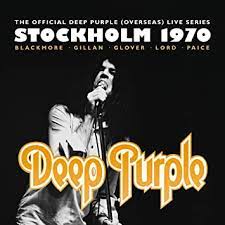DEEP PURPLE : STOCKHOLM 1970
Disc One (79:21)
- Speed King
- Into The Fire
- Child In Time
- Wring That Neck
- Paint It, Black
Disc Two (74:28)
- Mandrake Root
- Black Night
Bonus (Paris 1970) : - Wring that neck
- mandrake root
- 1971 Jon lord interview
Label : Ear Music
Venue : Konserthuset, Stockholm, Sweden
Recording Date : November 12, 1970
Release Date : March 7, 2014
Review (Discogs) : All tracks recorded live at Stockholm Konserthuset, November 12th, 1970. Except tracks 2-3 & 2-4 recorded November 1st, 1970 at Olympia Music Hall, Paris.
Review (Amazon) : Limited three disc (two CDs + DVD) live release from the celebrated MKII line up. In June '70, just five months prior to the recording of this incendiary Scandi-performance, Purple had unleashed "In Rock", the album that both created and defined heavy Rock. For Purple, "In Rock" was the ultimate statement of intent. "In Rock" was the turning point in the band's career. So to the Swedish capital of Stockholm on November 12, 1970. Here, at the Konserthuset venue, riding high on in Rock's success, Purple had one simple, single-minded aim: To stretch the infant Heavy Rock genre to breaking point. With no borders, no boundaries, unburdened by gimmickry or heritage, on this live recording Purple simply erupt. There's an endearing naiveté to Purple's performance, too. A sense that, in unleashing the beast, the band didn't quite know how savage and dangerous this feral being would become.
Review (Amazon) : In order to review this album, it must be put in context. In the late 1960's Deep Purple released three studio albums, “Shades Of...”, “Book of Taliesyn” and “Deep Purple.” It had two hits, “Hush” and “Kentucky Woman.” Then, it parted ways with its charismatic lead singer, Rod Evans, and bass player, Nicky Simper. For a band, this is typically asking for disaster. In 1969, with a new singer, an unknown Ian Gillan, and bass player, Roger Glover, Deep Purple released “Concerto for Group and Orchestra.” What was Deep Purple thinking? If the line up change did not kill the band, then releasing a cross over record of limited appeal certainly would. Yet, in June of 1970, before the band could be declared dead, it released “In Rock.” How do you reconcile these two albums? Not only did the band now have an identity crisis, when its record company failed, it was also broke. So what does a band do? It goes on the road to find its audience. Hopefully, it also makes enough money to keep the band together and generate enough sales to enable it to record another album. That brings us to “Stockholm 1970,” recorded on November 12, 1970. Eight months later, you have “Long Beach 1971", recorded on July 30, 1971. There are differences. When “Stockholm 1970" was recorded, Deep Purple could and did stretch out, developing its material, figuring out what worked and what did not with its audience. The album clocks in at around two hours. When “Long Beach 1971" was recorded, Deep Purple was the warm up act for the Faces. It did not have the luxury of unlimited time. The album clocks in at a little over an hour. Due to this time constraint, along with the additional months of touring, of the two albums, “Long Beach 1971" is tighter and more concise. There are no wasted notes. Deep Purple was in the United States, before a big audience, and this was its opportunity to make an impression. It is easy to look back now, but at that point in the band’s history, every performance had to be do or die. If I had to choose between the two albums, I would not. I would buy both. Years ago, these two albums were available on bootlegs at enormous cost. What you are paying for them today is laughably small, considering that they are finally available and have been remixed, remastered and sound great. That having been said, for the reasons I mention, if I wanted to relive Deep Purple live, before its masterpiece, “Machinehead,” and what may well be the best rock live album ever, “Made in Japan,” I would reach for “Long Beach 1971.”
